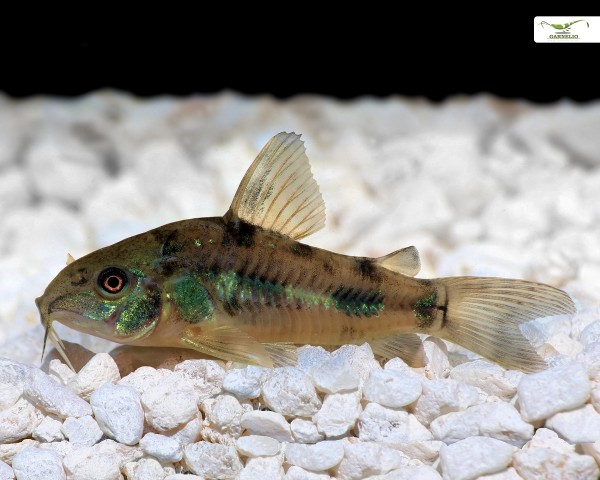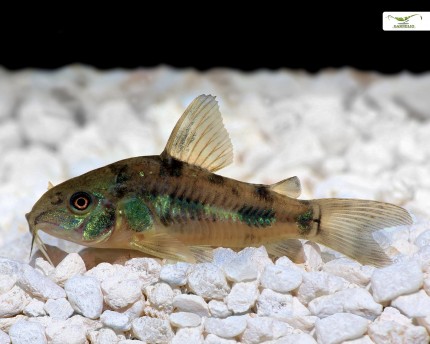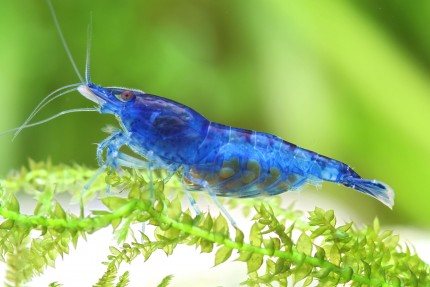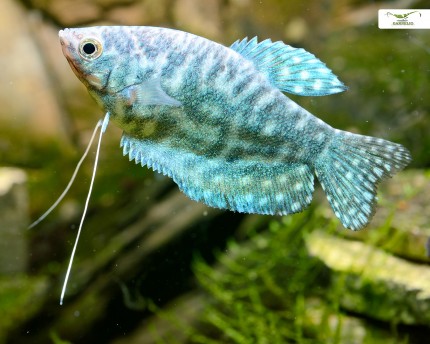incl. VAT plus shipping costs
Immediate delivery, express possible ![]()
More than 20 Articles in stock
Delivery only innh. Germany and Austria possible.
Switch to the German store
- Item no: 7723
Fast delivery times
All products are in stock with us!14 years of breeding experience
Let our team of experts advise you!High customer satisfaction
from over 3,000 reviews "| Water values: | soft to medium hard |
| Visual effect: | Swarm behavior |
| Temperature: | 20-25 °C |
| Behavior: | Active |
| Feature: | Interesting coloring |
| with fish?: | Yes, with peaceful fish |
| Pelvic region: | Below |
| Fish group: | Catfish |
| Aquarium size: | 100 l (approx. 80cm) |
| Difficulty: | 2 - Normal |
| Origin: | South America |
| with shrimps?: | with dwarf shrimp, offspring may be eaten |
| Diet: | omnivorous - omnivorous |
| Planting possible?: | Yes |
| with snails/shells?: | Yes |
| Final size: | 4-8 cm |
| with large crabs?: | No |
| Breeding: | heavy |
| with dwarf crabs?: | No |
| with crabs?: | No |
One of the most well-known and popular Corydoras is probably the Marbled Corydoras or also Marbled Corydoras. This South American catfish has enjoyed great popularity in aquaristics for a long time, especially as a very compatible by-fish in a beautifully designed soft water tank that brings the substrate to life. On its very yellowish basic color it shows spots, marbling and shading over the whole body. This can include a greenish iridescence on the gill cover to above the lateral line. The underside of the belly is pale, and the caudal fin is striped. The dorsal and anal fins of this handsome fellow may be lightly shaded. Its scientific species name "paleatus" is derived from the Latin words "chaff" and "spotted".
You will receive our Corydoras paleatus DNZ mixed-sex.
Mainly the animals differ from each other in adulthood, where they can reach almost 6 cm final size. The females become much stronger and rounder than the males.
Corydoras paleatus can also reproduce in the aquarium if well cared for. Preferably, one pair is placed in a breeding aquarium and allowed to spawn there. The adhesive spawners can stick up to 300 eggs to the interior, but also to plants and the glass. The young fish can be raised with freshly hatched Artemia nauplii.
Marbled Corys originate from flow areas of the Brazilian Rio Grande do Sul and should therefore also find clean and soft water, as well as a certain flow in the aquarium. They can be maintained already in aquariums starting from 80 cm edge length very well and prefer thereby sandy Bodengründe, in which they can dig around the whole day and do not hurt thereby their sensitive Bartelpaare. There they also feed on the food left over by the fish. Many hiding places and caves also promote their well-being. The marbled catfish is also an intestinal breather that regularly swims to the water surface for air. Therefore, when planting floating plants , care should be taken to ensure that it always has free access to the surface. It also dislikes bright lighting and prefers dense planting in places where it can retreat. Regular water changes and soft to medium hard water suit the Corydoras paleatus very well. Since they take care of themselves very quickly, you should definitely keep these very sociable and social animals in a group with at least 5 animals.
This peaceful Corydoras is excellent for socializing. In large aquariums they can also be kept in groups with other Cory catfish or Loricariids be combined. As by-fish they are suitable prima also for Angelfish, live-bearing Toothcarps, Tetras and Danios. The socialization with dwarf crayfish and crayfish is rather unsuitable. Well multiplying Dwarf shrimp species get along well with the Corydoras paleatus, only juveniles might be misunderstood as live food.
Corydoras paleatus is an omnivore, which is mainly interested in animal food. In the aquarium he eats apart from the food remains of his fellow inhabitants also commercial bottom tablets, food tablets, but also flake food or granulated food. With regular treats in the form of live or frozen food, such as mosquito larvae, Artemia or also Enchytraea it can certainly be spoiled.
Our food recommendation: The NatureHolic catfish feed for all aquarium sucker catfish that eat growth is a balanced tablet food, which does not cloud the water and the fish like to eat. The catfish tablets also contain NatureHolic active ingredient complexes, which provide the sucking catfish with everything they need for a strong immune system, healthy growth and great, contrasting coloration.
Our plant recommendation: For planting, use NatureHolic InVitros. These are free of snails, planarians and other unwanted co-inhabitants. Also free of algae spores, bacteria and fungi.
Expert Tip: We recommend for fish keeping the NatureHolic 3 Phase Liquid. The care set offers the best all-round protection for your animals. It ensures optimal conditions for successful breeding and keeping.
| Scientific name: | Corydoras paleatus |
| German name: | Marbled armored catfish, marbled armored catfish |
| Difficulty level: | for beginners |
| Origin/Distribution: | South America |
| Coloration: | yellow-gray ground color with many marbling distributed over the body, ventral side light colored |
| Age expectancy | approx. 8 years |
| Water parameters: | GH 2 to 19, KH 0 to 8, pH 6 to 7.5, tem-perature 22 to 26 °C |
| Tank size: | from 80 l |
| Food | Omnivorous with emphasis on animal food, frozen food, live food of suitable size, flake food, granulated food, special food for pan-catfish |
| Breeding | relatively difficult |
| Behavior | peaceful |
| Group size | 5-10 animals |
| Further information | Ten typical aquarium fish for beginners and alternatives to them, Tips for acclimating fish to the aquarium, Feeding aquarium fish properly - cheap food and what it can do |
- Item no: 7723
- EAN No.: 7427061495119
Entdecke die Garnelio Welt!
Garnelio gehört zu den größten Onlineshops für wirbellose Aquarientiere weltweit.
Viele Artikel gibt es exklusiv nur bei uns im Shop.












































The fields marked with * are required.
I have taken note of the privacy policy.